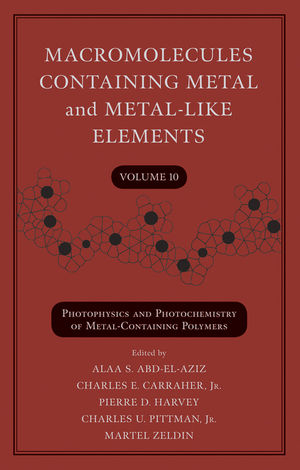Macromolecules Containing Metal and Metal-Like Elements, Volume 10: Photophysics and Photochemistry of Metal-Containing PolymersISBN: 978-0-470-59774-3
Hardcover
448 pages
May 2010
 |
||||||
Series Preface.
1. Introduction to Photophysics and Photochemistry (Shawkat M. Aly, Charles E. Carraher Jr., and Pierre D. Harvey).
I. General.
II. Photophysics and Photochemistry.
III. Light Absorption.
IV. Luminescence.
V. Emission Lifetime.
VI. Ground and Excited State Molecular Interactions.
A. Energy and Electron Transfer (Excited State Interactions and Reactions).
B. Energy Transfer.
C. Electron Transfer.
VII. Nonlinear Optical Behavior.
VIII. Photoconductive and Photonic Polymers.
IX. Photosynthesis.
A. Purple Photosynthetic Bacteria.
B. Green Sulfur Bacteria.
X. Organometallic Polymers and Synthetic Photosynthesis Systems.
XI. Summary.
XII. References Additional Readings.
XIII. References.
2. Luminescent Organometallic Coordination Polymers Built on Isocyanide Bridging Ligands (Pierre D. Harvey, Sébastien Clément, Michael Knorr, and Jerome Husson).
I. Introduction.
II. Luminescent Organometallic Polynuclear Systems and Coordination Polymers Containing a Terminal Isocyanide Ligand.
III. Luminescent Polymeric Systems Containing an Isocyanide Ligand Assembled via M...M Interactions.
IV. Luminescent Organometallic Polymetallic Systems and Coordination Polymers Containing Bridging Isocyanides.
V. Conclusion.
VI. Acknowledgments.
VII. References.
3. Luminescent Oligomeric and Polymeric Copper Coordination Compounds Assembled by Thioether Ligands (Michael Knorr and Fabrice Guyon).
I. Introduction.
II. Background Informations.
III. Luminescent Copper Polymers Assembled by Thioether Ligands.
A. Copper Polymers Assembled by Monothioether Ligands RSR.
B. Copper Polymers Assembled by Aromatic Dithioether Ligands.
C. Copper Polymers Assembled by Aliphatic Dithioether and Polythioether Ligands.
D. Copper Polymers Assembled by Dithioether and Polythioether Ligands Bearing Heteroelements in the Spacer Unit.
IV. Conclusion.
V. Acknowledgments.
VI. References.
4. Applications of Metal Containing Polymers in Organic Solar Cells (Chris S. K. Mak and Wai Kin Chan).
I. Introduction.
II. Types of Organic Solar Cells.
A. Dye-Sensitized Solar Cells.
B. Organic Thin Film Solar cells.
III. Solar Cell Characterizations.
IV. Metal Containing Polymers in Solar Cells.
A. Dye-Sensitized Solar Cells.
B. Organic Thin Film Solar Cells.
V. Summary.
VI. Acknowledgments.
VII. References.
5. Functional Silole-Containing Polymers (Junwu Chen, Yong Cao, and Ben Zhong Tang).
I. Introduction.
II. Electronic Transition and Band Gap.
III. Light Emission.
A. Photoluminescence.
B. Electroluminescence.
IV. Bulk-Heterojuction Photovoltaic Cells.
V. Field Effect Transistors.
VI. Aggregation-Induced Emission.
VII. Chemosensors.
VIII. Conductivity.
IX. Optical Limiting.
X. Summary.
XI. Acknowledgments.
XII. References.
6. Photophysics and Photochemistry of Polysilanes for Electronic Applications (Starr Dostie, Cetin Aktik, and Mihai Scarlete).
I. Introduction.
II. Synthesis of Electronic-Grade Polysilanes.
III. Band Structure.
IV. Photophysics.
A. Influence of the Backbone Structure.
B. Side Groups.
C. Nanostructured Polysilanes.
D. PL Quenching by Doping.
E. Energy Transfer.
F. Electroluminescence.
G. Cathodoluminescence.
H. Interaction with Photoelectrons.
V. Photochemistry.
A. Photo-Oxidation.
VI. Polysilane Thin Films for Electronic Devices.
A. LED.
B. Photoconductors.
C. Photovoltaics.
D. Lithography.
E. Electron Beam.
VII. Polysilane Films for Optical Devices.
A. NLO.
VIII. Summary.
IX. References.
7. Polymers with Metal-Metal Bonds as Models in Mechanistic Studies of Polymer Photodegradation (David R. Tyler, Bevin Daglen, and Ginger Shultz).
I. Introduction.
II. Experimental Strategies.
III. Synthesis of Polymers with Metal-Metal Bonds along their Backbones.
A. Step-Growth Polymers.
B. ADMET Polymerization.
C. Chain-Growth Polymers.
IV. Photochemical Reactions of the Polymers in Solution.
V. Photochemistry in the Solid State.
VI. Factors Controlling the Rate of Polymer Photochemical Degradation in the Solid State.
A. Temperature Effects.
B. Interpreting the Kinetics of Polymer Degradation in the Solid State.
C. Photodegradation Rate Dependence on Polymer Curing Time.
D. The Effects of Stress on Polymer Degradation.
VII. Kinetics of Polymer Formation.
VIII. Concluding Remarks on the Importance of Radical-Radical Recombination on the Efficiency of Polymer Photochemical Degradation.
IX. Acknowledgments.
X. References.
8. Optical Properties and Photophysics of Platinum-Containing Poly (aryleneethynylene)s (Wai-Yeung Wong).
I. Introduction.
II. Synthetic Methods and Materials Characterization.
III. Optical and Photophysical Properties.
A. Energy Gap Law for Triplet States.
B. Phosphorescence Color Tuning of Metallopolyynes.
C. Roles of Metallopolyynes in Optoelectronic and Photonic Devices.
IV. Summary.
V. Acknowledgments.
VI. References.
9. Luminescence in Polymetallic Gold-Heteronuclear Derivatives (Antonio Laguna and Jose M. López-de-Luzuriaga).
I. Introduction and Background.
II. Luminescent Gold-Silver Derivatives.
A. Supramolecular Gold-Silver Complexes with Bidentate Ligands.
B. Supramolecular Gold-Silver Complexes with Tridentate Ligands.
C. Supramolecular Gold-Silver Complexes Built with Metallic Cationic and Anionic Counterparts.
III. Luminescent Gold-Copper Derivatives.
IV. Luminescent Gold-Thallium Derivatives.
A. Supramolecular Gold-Thallium Complexes with Bidentate Ligands.
B. Supramolecular Gold-Thallium Complexes through Acid-Base Reactions.
V. Luminescent Gold-Lead Derivatives.
VI. Luminescent Gold-Platinum Derivatives.
VII. Luminescent Gold-Mercury Derivatives.
VIII. Conclusion.
IX. References.
10. Functional Self-Assembled Zinc(II) Coordination Polymers (Chi-Chung Kwok and Chi-Ming Che).
I. Introduction.
II. Zinc(II) Terpyridine Polymers.
III. Zinc(II) Schiff Base Polymer.
IV. Summary.
V. Acknowledgment.
VI. References.
11. Redox and Photo Functions of Metal Complex Oligomer and Polymer Wires on the Electrode (Mariko Miyachi and Hiroshi Nishihara).
I. Introduction.
II. Bottom-Up Fabrication of Redox-Conducting Metal Complex Oligomers on an Electrode Surface and Their Redox Conduction Behavior.
A. Bottom-Up Fabrication of Metal Complex Oligomer and Polymer Wires.
B. Electron Transport Behavior of the Molecular Wires on the Electrode.
III. Photoelectric Conversion System Using Porphyrin and Redox-Conducting Metal Complex Wires.
A. Bottom-Up Fabrication of the Porphyrin-Terminated Redox-Conducting Metal Complex Film on ITO.
B. Photoelectrochemical Properties of the Porphyrin-Terminated Redox-Conducting Metal Complex Film on ITO.
IV. Biophotosensor and Biophotoelectrode Composed of Cyanobacterial Photosystem I and Molecular Wires.
A. Biophotosensor Composed of Cyanobacterial Photosystem I, Molecular Wire, Gold Nanoparticle, and Transistor.
B. Biophotoelectrode Composed of Cyanobacterial Photosystem I and Molecular Wires.
V. Conclusion.
VI. References.
Index.



